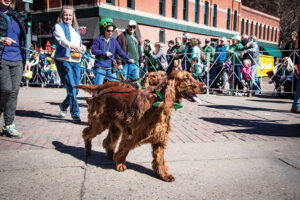 Who says blondes have more fun? Any self-respecting Irish Setter would dispute that claim. These fun-loving dogs are tremendously likeable, not only for their flame-colored hair, but also for their athleticism, grace, and enthusiasm. When you live with an Irish Setter, you can be assured of having a happy, friendly companion who’s always ready to rock and roll.
Who says blondes have more fun? Any self-respecting Irish Setter would dispute that claim. These fun-loving dogs are tremendously likeable, not only for their flame-colored hair, but also for their athleticism, grace, and enthusiasm. When you live with an Irish Setter, you can be assured of having a happy, friendly companion who’s always ready to rock and roll. Originally developed as a bird dog, the Irish Setter retains the drive and energy of his forefathers. There’s nothing he enjoys more than doing new things and going new places, especially if they involve birds. Although he’s not seen as much in the field as some other sporting breeds, his hunting instinct is still strong. Once he’s trained on birds, he never needs a refresher course.
While the Irish Setter loves everyone, he’s not suited to every home. He’s brimming with energy and requires a minimum of an hour of exercise daily. A large fenced yard or acreage where he can run is important, as is an active family who will include him in everything they do. He can develop separation anxiety or become destructive if he’s left to his own devices.
Irish Setters come in two types: show and field dogs. Irish Setter show dogs are heavier and larger than field dogs, with a heavier, thicker coat. Both types meet the breed standard — a written description of how a breed should look and act. Regardless of size and coat, the Irish Setter should maintain his natural ability to be a gundog.
Beyond their talents in the field, Irish Setters excel at many other activities, including obedience, rally, tracking, and agility competition. With their wonderful temperaments, they make terrific therapy dogs and can be found visiting hospices, retirement homes, and children’s hospitals, spreading the gift of their warmth, humor, and love.
Irish Setters are known for their intelligence, but they’re also mischievous and independent. Training them requires much patience and consistency. This breed is slow to mature, so you’ll have a full-grown dog with puppylike enthusiasm and activity levels for several years. Not surprisingly, they’re great playmates for active older children, but they can be overwhelming for toddlers, who may find themselves bowled over by this rascally redhead.
The Irish Setter has been loved by movie stars, presidents, and ordinary people who admire him for his joyful spirit. He’s a wonderful companion who will keep you fit and make you laugh throughout your life.
The Irish Setter is a high-spirited gundog known for grace, swiftness, and a flashy red coat. They are famously good family dogs: sweet-tempered companions for the folks, and rollicking playmates and tennis-ball fetchers for the children. The Irish Setter has been described by its partisans as the most beautiful of dog breeds. Standing more than two feet at the shoulder, with a substantial yet elegant build, the Irish is famed for a brilliant coat of mahogany or chestnut. Long, sinewy legs and powerful rear drive help to place the Irish among the swiftest of all sporting dogs. The Irish Setter’s lovable personality has endeared the breed to sportsmen and pet owners for more than 200 years. Irish are outgoing dogs who enjoy making friends. These rambunctious redheads are big kids at heart, but they are eager to please and will respond to patient, positive training. They are said to be bold and rugged hunting partners, with a devil-may-care approach to their work.
Irish Setters become very attached to the people in their lives and can suffer from serious separation anxiety. They become very unhappy when they are left alone for more than a few hours and this unhappiness usually results in destructive behavior. Irish Setters do not make good outdoor dogs and need to stay inside, close to their family.
The high-energy, athletic Irish Setter needs room to run and the best place for him to do that is in a large, fenced yard. Irish Setters need lots of exercise and should be exercised twice a day for at least half an hour each time. Irish Setters need obedience training to channel their mischievous and sometimes stubborn nature.
Irish Setters do very well with other animals and children. It is important, however, to properly socialize your puppy regardless of the breed’s temperament or your living situation. You might not have children or other pets now, but that could change. Lack of socialization can cause many difficulties.
Irish Setters need to be groomed daily or every other day to keep their long, silky coats from becoming tangled. They are moderate shedders, so you will have some hair in your house, especially during shedding seasons. Irish Setters do not mature quickly. Some dogs settle down by the age of 2, but others remain puppylike their entire lives.
Irish Setters are inquisitive by nature and will get into anything they can find or reach. This trait can also make training more difficult because they generally have a hard time staying focused. If you can keep them interested in training, they learn quickly.
To get a healthy dog, never buy a puppy from an irresponsible breeder, puppy mill, or pet store. Look for a reputable breeder who tests her breeding dogs to make sure they’re free of genetic diseases that they might pass onto the puppies, and that they have sound temperaments.
History
It’s not surprising that this handsome redhead comes from Ireland, which is famous for fine and beautiful dogs. The Irish Setter appears to have been developed there in the 18th century, probably the result of combining English Setters, spaniels, pointers, and Gordon Setters.
Those first Irish Setters were sometimes called red spaniels — a clue to their heritage, perhaps — or modder rhu, Gaelic for “red dog.” Often, they were white and red instead of the solid dark red we see today. Some, described as “shower of hail” dogs, had red coats sprinkled with small white spots. The Irish Earl of Enniskillen may have started the fad for solid red dogs. By 1812, he would have no other kind in his kennels. Other Irish breeders of the time who preferred the red dogs were Jason Hazzard of Timaskea in County Fermanagh and Sir St. George Gore.
A dog named Elcho was the first Irish Setter imported to the United States. He arrived in 1875 and became a star not only in the show ring but also in the field. The first Irish Setter registered by the American Kennel Club was Admiral, in 1878.
They quickly became one of the most popular breeds in America and a favorite in the show ring. Between 1874 and 1948, 760 Irish Setters became conformation champions, while only five became field champions. This sparked alarm for some fanciers of the original breed, and in 1940 the magazine Field and Stream called for a resurrection of the breed as a working dog.
Today, it’s not unusual to see two types: the larger, heavier show dog, and the lighter, sleeker field dog. The Irish Setter’s popularity soared in the 1960s and 1970s, thanks to the books and movie featuring an Irish Setter named Big Red, as well as the presence of Irish Setter King Timahoe at the White House during the Nixon administration.
Today, the Irish Setter ranks 68th among the 155 breeds and varieties recognized by the AKC. Size The typical male Irish Setter stands 27 inches at the shoulder and weighs 70 pounds; females are 25 inches and weigh 60 pounds.

















Follow Us